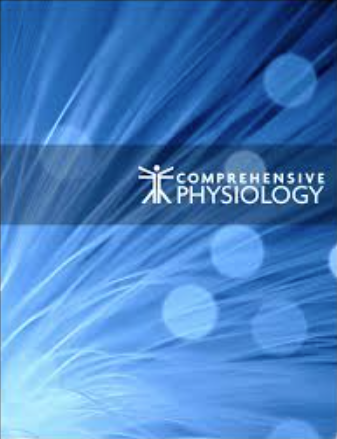下载PDF
{"title":"健康和疾病中肾小管对葡萄糖和果糖的处理。","authors":"Volker Vallon, Takahiko Nakagawa","doi":"10.1002/cphy.c210030","DOIUrl":null,"url":null,"abstract":"<p><p>The proximal tubule of the kidney is programmed to reabsorb all filtered glucose and fructose. Glucose is taken up by apical sodium-glucose cotransporters SGLT2 and SGLT1 whereas SGLT5 and potentially SGLT4 and GLUT5 have been implicated in apical fructose uptake. The glucose taken up by the proximal tubule is typically not metabolized but leaves via the basolateral facilitative glucose transporter GLUT2 and is returned to the systemic circulation or used as an energy source by distal tubular segments after basolateral uptake via GLUT1. The proximal tubule generates new glucose in metabolic acidosis and the postabsorptive phase, and fructose serves as an important substrate. In fact, under physiological conditions and intake, fructose taken up by proximal tubules is primarily utilized for gluconeogenesis. In the diabetic kidney, glucose is retained and gluconeogenesis enhanced, the latter in part driven by fructose. This is maladaptive as it sustains hyperglycemia. Moreover, renal glucose retention is coupled to sodium retention through SGLT2 and SGLT1, which induces secondary deleterious effects. SGLT2 inhibitors are new anti-hyperglycemic drugs that can protect the kidneys and heart from failing independent of kidney function and diabetes. Dietary excess of fructose also induces tubular injury. This can be magnified by kidney formation of fructose under pathological conditions. Fructose metabolism is linked to urate formation, which partially accounts for fructose-induced tubular injury, inflammation, and hemodynamic alterations. Fructose metabolism favors glycolysis over mitochondrial respiration as urate suppresses aconitase in the tricarboxylic acid cycle, and has been linked to potentially detrimental aerobic glycolysis (Warburg effect). © 2022 American Physiological Society. Compr Physiol 12:2995-3044, 2022.</p>","PeriodicalId":10573,"journal":{"name":"Comprehensive Physiology","volume":"12 1","pages":"2995-3044"},"PeriodicalIF":4.2000,"publicationDate":"2021-12-29","publicationTypes":"Journal Article","fieldsOfStudy":null,"isOpenAccess":false,"openAccessPdf":"https://www.ncbi.nlm.nih.gov/pmc/articles/PMC9832976/pdf/nihms-1859851.pdf","citationCount":"0","resultStr":"{\"title\":\"Renal Tubular Handling of Glucose and Fructose in Health and Disease.\",\"authors\":\"Volker Vallon, Takahiko Nakagawa\",\"doi\":\"10.1002/cphy.c210030\",\"DOIUrl\":null,\"url\":null,\"abstract\":\"<p><p>The proximal tubule of the kidney is programmed to reabsorb all filtered glucose and fructose. Glucose is taken up by apical sodium-glucose cotransporters SGLT2 and SGLT1 whereas SGLT5 and potentially SGLT4 and GLUT5 have been implicated in apical fructose uptake. The glucose taken up by the proximal tubule is typically not metabolized but leaves via the basolateral facilitative glucose transporter GLUT2 and is returned to the systemic circulation or used as an energy source by distal tubular segments after basolateral uptake via GLUT1. The proximal tubule generates new glucose in metabolic acidosis and the postabsorptive phase, and fructose serves as an important substrate. In fact, under physiological conditions and intake, fructose taken up by proximal tubules is primarily utilized for gluconeogenesis. In the diabetic kidney, glucose is retained and gluconeogenesis enhanced, the latter in part driven by fructose. This is maladaptive as it sustains hyperglycemia. Moreover, renal glucose retention is coupled to sodium retention through SGLT2 and SGLT1, which induces secondary deleterious effects. SGLT2 inhibitors are new anti-hyperglycemic drugs that can protect the kidneys and heart from failing independent of kidney function and diabetes. Dietary excess of fructose also induces tubular injury. This can be magnified by kidney formation of fructose under pathological conditions. Fructose metabolism is linked to urate formation, which partially accounts for fructose-induced tubular injury, inflammation, and hemodynamic alterations. Fructose metabolism favors glycolysis over mitochondrial respiration as urate suppresses aconitase in the tricarboxylic acid cycle, and has been linked to potentially detrimental aerobic glycolysis (Warburg effect). © 2022 American Physiological Society. Compr Physiol 12:2995-3044, 2022.</p>\",\"PeriodicalId\":10573,\"journal\":{\"name\":\"Comprehensive Physiology\",\"volume\":\"12 1\",\"pages\":\"2995-3044\"},\"PeriodicalIF\":4.2000,\"publicationDate\":\"2021-12-29\",\"publicationTypes\":\"Journal Article\",\"fieldsOfStudy\":null,\"isOpenAccess\":false,\"openAccessPdf\":\"https://www.ncbi.nlm.nih.gov/pmc/articles/PMC9832976/pdf/nihms-1859851.pdf\",\"citationCount\":\"0\",\"resultStr\":null,\"platform\":\"Semanticscholar\",\"paperid\":null,\"PeriodicalName\":\"Comprehensive Physiology\",\"FirstCategoryId\":\"3\",\"ListUrlMain\":\"https://doi.org/10.1002/cphy.c210030\",\"RegionNum\":2,\"RegionCategory\":\"医学\",\"ArticlePicture\":[],\"TitleCN\":null,\"AbstractTextCN\":null,\"PMCID\":null,\"EPubDate\":\"\",\"PubModel\":\"\",\"JCR\":\"Q1\",\"JCRName\":\"PHYSIOLOGY\",\"Score\":null,\"Total\":0}","platform":"Semanticscholar","paperid":null,"PeriodicalName":"Comprehensive Physiology","FirstCategoryId":"3","ListUrlMain":"https://doi.org/10.1002/cphy.c210030","RegionNum":2,"RegionCategory":"医学","ArticlePicture":[],"TitleCN":null,"AbstractTextCN":null,"PMCID":null,"EPubDate":"","PubModel":"","JCR":"Q1","JCRName":"PHYSIOLOGY","Score":null,"Total":0}
引用次数: 0
引用
批量引用




